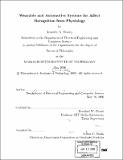| dc.contributor.advisor | Rosalind W. Picard. | en_US |
| dc.contributor.author | Healey, Jennifer Anne | en_US |
| dc.contributor.other | Massachusetts Institute of Technology. Dept. of Electrical Engineering and Computer Science. | en_US |
| dc.date.accessioned | 2005-08-24T19:24:20Z | |
| dc.date.available | 2005-08-24T19:24:20Z | |
| dc.date.copyright | 2000 | en_US |
| dc.date.issued | 2000 | en_US |
| dc.identifier.uri | http://hdl.handle.net/1721.1/9067 | |
| dc.description | Thesis (Ph.D.)--Massachusetts Institute of Technology, Dept. of Electrical Engineering and Computer Science, 2000. | en_US |
| dc.description | Includes bibliographical references (p. 152-158). | en_US |
| dc.description.abstract | Novel systems and algorithms have been designed and built to recognize affective patterns in physiological signals. Experiments were conducted for evaluation of the new systems and algorithms in three types of settings: a highly constrained laboratory setting, a largely unconstrained ambulatory environment, and a less unconstrained automotive environment. The laboratory experiment was designed to test for the presence of unique physiological patterns in each of eight different emotions given a relatively motionless seated subject, intentionally feeling and expressing these states. This experiment generated a large dataset of physiological signals containing many day-to-day variations, and the proposed features contributed to a success rate of 81% for discriminating all eight emotions and rates of up to 100% for subsets of emotion based on similar emotion qualities. New wearable computer systems and sensors were developed and tested on subjects who walked, jogged, talked, and otherwise went about daily activities. Although in the unconstrained ambulatory setting, physical motion often overwhelmed affective signals, the systems developed in this thesis are currently useful as activity monitors, providing an image diary correlated with physiological signals. Automotive systems were used to detect physiological stress during the natural but physically driving task. This generated a large database of physiological signals covering over 36 hours of driving. Algorithms for detecting driver stress achieved a recognition rates of 96% using stress ratings based on task conditions for validation and 89% accuracy using questionnaires analysis for validation. Further results in which metrics of stress from video tape annotations of the drive were correlated with physiological features showed highly significant correlations (up to r = .77 for over 4000 samples). Together, these three experiments show a range of success in recognizing affect from physiology, showing high recognition rates in somewhat constrained conditions and highlighting the need for more automatic context sensing in unconmore automatic context sensing in unconstrained conditions. The recognition rates obtained thus far lend support to the hypothesis that many emotional differences can be automatically discriminated in patterns of physiological changes. | en_US |
| dc.description.statementofresponsibility | by Jennifer A. Healey. | en_US |
| dc.format.extent | 158 p. | en_US |
| dc.format.extent | 16858715 bytes | |
| dc.format.extent | 16858472 bytes | |
| dc.format.mimetype | application/pdf | |
| dc.format.mimetype | application/pdf | |
| dc.language.iso | eng | en_US |
| dc.publisher | Massachusetts Institute of Technology | en_US |
| dc.rights | M.I.T. theses are protected by copyright. They may be viewed from this source for any purpose, but reproduction or distribution in any format is prohibited without written permission. See provided URL for inquiries about permission. | en_US |
| dc.rights.uri | http://dspace.mit.edu/handle/1721.1/7582 | |
| dc.subject | Electrical Engineering and Computer Science. | en_US |
| dc.title | Wearable and automotive systems for affect recognition from physiology | en_US |
| dc.type | Thesis | en_US |
| dc.description.degree | Ph.D. | en_US |
| dc.contributor.department | Massachusetts Institute of Technology. Department of Electrical Engineering and Computer Science | |
| dc.identifier.oclc | 46803357 | en_US |
